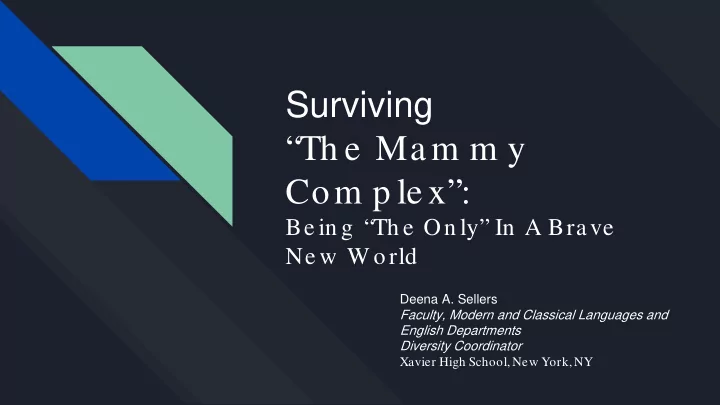

Surviving “Th e Mam m y Com p le x”: Be in g “Th e On ly” In A Brave Ne w W orld Deena A. Sellers Faculty, Modern and Classical Languages and English Departments Diversity Coordinator Xavier High School, New York, NY
But first, an anecdote... But first, an anecdote... How I got “othered” in two minutes flat… … and what I learned - ★ People’s guilt is not my problem. ★ Personal space is a privilege, not a right. ★ Sometimes saying nothing is the best thing to do.
OBJECTIVES: QTNA OBJECTIVES: QTNA ★ How does the Mammy fit into our classroom landscape, and what does she offer to our 21st century students? ★ Why is she sought after and revered by those who may not completely understand her? ★ What can we do to assure that women in this position are protected, encouraged, and supported in her otherness?
WHO IS MAMMY? WHO IS MAMMY?
IN 21st CENTURY TERMS... IN 21st CENTURY TERMS... ★ In majority white schools, this manifests in “the only”: the one woman of color on our faculties who take a lead role in “raising” black, brown AND white students. ★ She is often called upon to assist, inform, and manage up: guidance counselors, administrators, and her peers... ★ … and held to a much higher standard and expectation than others: e.g. tenure requirements, education/scholarly pursuits, community involvement, faith formation.
TRUTH AND CONSEQUENCES TRUTH AND CONSEQUENCES Truth is: “Being black and female in the workplace means constantly having to walk a tightrope, balancing your own emotions with the perceptions and intentions of others, making everyone feel comfortable, instead of nervous, in the process.” (Cheeks, LennyLetter.com) ★ Because… DIVERSITY!! ★ Sponsorship = Consideration ★ Caring and being nice is not inclusive.
BUT AT WHAT COST? BUT AT WHAT COST? ★ Stereotype threat: when being “the only” brings anxiety around confirming negative stereotypes ★ Racial battle fatigue and double jeopardy : the exhaustive task of doing your job while keeping your job; the effect of being judged more harshly while making the same mistakes, working twice as hard to get half the distance, and feeling the same burnout as a result (see also sponsorship , implicit bias , microaggressions ) ★ Consciousness raising as a personal responsibility ★ Social capital: authentic connections as a strengthening tool, but for whom?
STOP AND THINK… and REFLECT STOP AND THINK… and REFLECT (Glamour, 2017) (Glamour, 2017) “I am visible --see this Indian face --yet I am invisible. I both blind them with my beak nose and am their blind spot. But I exist, we exist. They'd like to think I have melted in the pot. But I haven't. We haven't.” -Gloria Andalzua
“THE ONLY…” “THE ONLY…” … Muslim woman: “I used to feel sad and confused that people were judging me on my faith rather than my skill as a lawyer. But deep down I know my clients are responding to negative media portrayals of Muslims, and I dismantle that by being a human being.” -Dua, 29, attorney
“THE ONLY…” “THE ONLY…” … black woman: “Then there’s my Afro - when I shaved the sides, the new style got more commentary that I imagine a white woman’s hair would get. One colleague said my hair reminded her of the Fresh Prince of Bel Air . Another agreed.” -Paige, 26, paralegal
“THE ONLY…” “THE ONLY…” … unmarried, childless woman: “Even though I’m not a parent, I understand what it takes to be one, and I can help someone through a crisis.” -Melissa, 35, grief counselor
“THE ONLY…” “THE ONLY…” … trans woman: “Though I never felt unsafe (at work), I worried about being harrassed in the bathroom we shared with other people in the building. Some days I would just hold it in until I went home.” -Dee, 33, designer
TALK AMONGST YOURSELVES... TALK AMONGST YOURSELVES... 1. What is the best way to build social capital in an authentic way in school communities? 2. Try and empathize with one of these stories. What emotions arise? 3. Name some tangible and specific things that women of color need to feel supported and empowered without being “sponsored”? 4. GIve an example of when you have felt “othered”. How did you deal and what was the result? 5. How can we diversify with purpose in our schools?
OBJECTIVES REVISITED: QTNA OBJECTIVES REVISITED: QTNA ★ How does the Mammy fit into our classroom landscape, and what does she offer to our 21st century students? ★ Why is she sought after and revered by those who may not completely understand her? ★ What can we do to assure that women in this position are protected, encouraged, and supported in her otherness?
WORK CITED WORK CITED Cheeks, Maura. “The Stress of Being The Only Black Woman at Work.” LennyLetter.com, 16 January 2018. Kowalski, Jessica. “Stereotypes of History: Reconstructing Truth and The Black Mammy.” transcending silence, University at Albany - SUNY, Albany NY, Spring 2009. Liebman, Lisa. “At Work I’m The Only”. Glamour p. 148 -149, Condé Nast International, April 2017.
THANK YOU!! THANK YOU!! Deena A. Sellers Faculty, Modern and Classical Languages and English Departments Diversity Coordinator Xavier High School, New York, NY Email: Sellersd@xavierhs.org
Recommend
More recommend